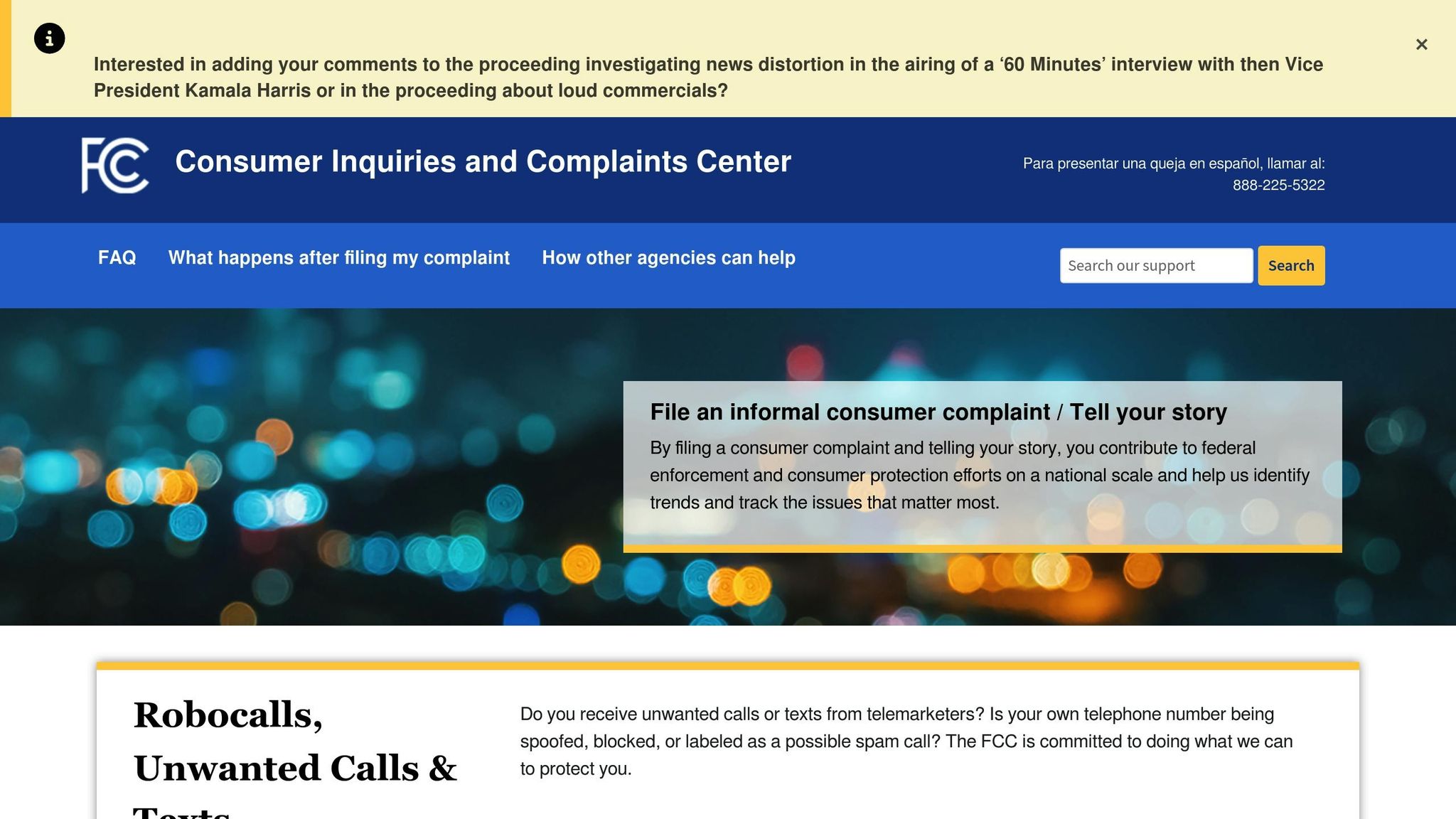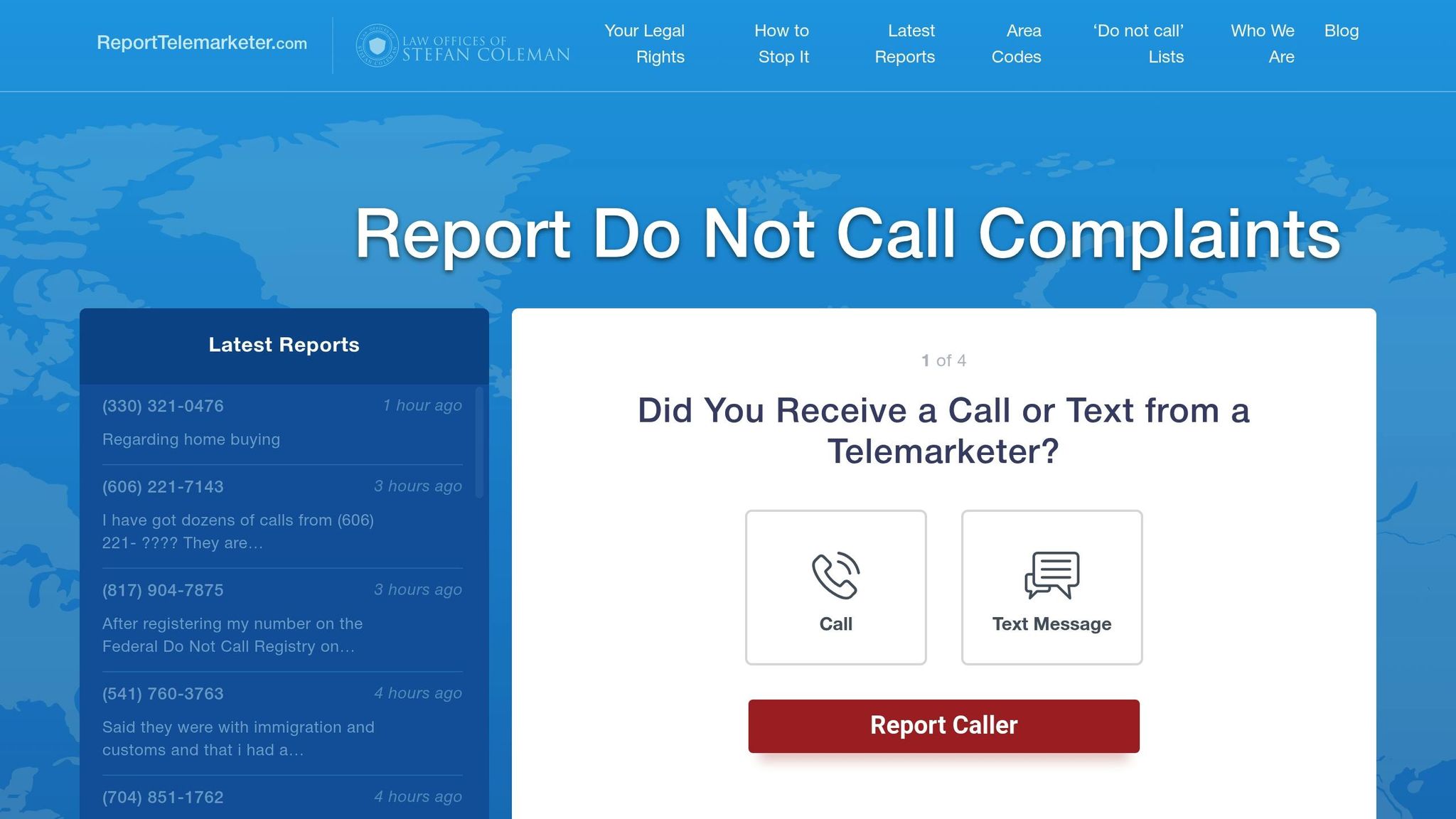
Filing a complaint with the FCC is a straightforward way to stop unwanted telemarketing calls, robocalls, or spam texts. Here’s how you can take action:
- What You Can Report: Robocalls, spam texts, Do Not Call violations, caller ID spoofing, and calls outside allowed hours.
- What You Need: Dates, times, phone numbers, company names, call content, and proof of prior opt-out attempts.
- How to File:
- Online: Visit the FCC Consumer Complaint Center.
- Phone: Call 1-888-CALL-FCC.
- Mail: Send details to their Washington, DC address.
- Third-Party: Use services like ReportTelemarketer.com for additional support.
Tip: Keep a record of all interactions and your complaint reference number to track progress. Filing complaints helps identify violators and can lead to enforcement actions.
How to File a Complaint with the Federal Communications Commission
How FCC Complaints Work

The FCC oversees telecommunications to safeguard consumers. Understanding what falls under their jurisdiction and knowing when to file a complaint can make your report more effective.
What the FCC Regulates
The FCC focuses on several key areas, including:
- Unwanted Robocalls: Automated calls using artificial or prerecorded messages.
- Text Message Spam: Unsolicited promotional texts sent without your consent.
- Do Not Call Violations: Calls you receive despite being on the National Do Not Call Registry.
- Caller ID Spoofing: Calls where the caller ID is manipulated to mislead you.
- Time Restrictions: Calls made before 8 AM or after 9 PM in your local time zone.
For instance, ReportTelemarketer.com tracked repeated calls from Tiffin, Ohio (949-818-1157, 949-818-1162, 949-818-1173). These calls persisted even after removal requests, highlighting a pattern that may warrant FCC action.
Valid Reasons to File
Not sure if your situation qualifies for an FCC complaint? Check these common scenarios:
| Complaint Type | Reasons to File |
|---|---|
| Robocalls | Automated calls received without prior consent or continuing after opting out. |
| Text Messages | Promotional texts sent without permission or lacking opt-out instructions. |
| Do Not Call | Calls received more than 31 days after registering on the DNC list. |
| Caller ID | Calls showing fake or misleading caller ID information. |
| Consent Issues | Calls continuing after you explicitly asked to stop or outside allowed hours. |
"As a consumer protection firm, we use the telephone consumer protection laws to stop telemarketers from harassing you." – ReportTelemarketer.com
When filing a complaint, make sure to document:
- The date and time of each call or text.
- The phone numbers used by the telemarketer.
- Any company names or identifiers provided.
- The content or purpose of the communication.
- Your efforts to stop the unwanted contact.
Once you’ve gathered this information, you’re ready to submit your complaint to the FCC.
Filing Your FCC Complaint
What You’ll Need
Before filing a complaint with the FCC, make sure you have all the necessary details ready. Here’s what you’ll need:
Personal Information:
- Your full name and contact details
- The best time for the FCC to reach you
- Your preferred method of contact (phone, email, etc.)
- The name of your service provider
Details About the Violation:
- The phone number that contacted you
- Dates and times of the incidents
- The type of violation (like robocalls or spam texts)
- Any company or representative names mentioned
- Call recordings or screenshots, if you have them
- Information on any previous attempts you’ve made to stop the communication
Filing Online: Step-by-Step
The FCC’s online complaint system makes reporting violations straightforward. Here’s how to do it:
- Go to the FCC Consumer Complaint Center website.
- Select "Phone" under the complaint category.
- Choose the specific issue, such as "Unwanted Calls."
- Fill in the required fields and upload any supporting evidence.
- Double-check your submission for accuracy.
- Submit your complaint and save the reference number for future tracking.
If you’re unable to file online, don’t worry – there are other ways to submit your complaint.
"The personal information collected depends on the context of the interactions and the choices made by the user." – ReportTelemarketer.com
Other Ways to File
If online filing isn’t an option, you can use one of these methods:
| Filing Method | Contact Details |
|---|---|
| Phone | Call 1-888-CALL-FCC |
| FCC Consumer Complaint Center, 45 L Street NE, Washington, DC 20554 | |
| Third-Party Service | Use the online form at ReportTelemarketer.com |
When mailing your complaint, include copies (not originals) of any supporting evidence.
Note: If you choose to file through a third-party service like ReportTelemarketer.com, your email and phone number will be kept private. However, details such as the spammer’s phone number and call information might be publicly shared to help others identify telemarketers.
Keep copies of everything you submit to assist with the FCC’s review and tracking process.
sbb-itb-a8d93e1
Next Steps After Filing
After submitting your complaint, here’s how to stay on top of the process.
FCC Review Process
The FCC will examine your submission and any supporting evidence to decide whether further action is necessary.
Expected Response Time
The time it takes to get a response depends on the complexity of your case and the number of complaints being handled. Be sure to check for updates regularly.
Track Your Complaint
You can monitor your complaint through the FCC Consumer Complaint Center website using the reference number provided. If you filed through ReportTelemarketer.com, their system will manage parallel investigations.
"ReportTelemarketer.com investigates telemarketer complaints using proprietary tools and systems. If the telemarketer is identified and did not have consent to call, ReportTelemarketer.com may file a cease and desist letter or a formal complaint."
Make sure to keep your reference number handy for any follow-up actions.
More Ways to Report Telemarketers
In addition to filing complaints with the FCC, there are other ways to take action against telemarketers.
ReportTelemarketer.com

This platform provides a free service to help consumers stop unwanted telemarketing calls and texts. Here’s what it offers:
| Feature | Details |
|---|---|
| Cost | Free for users |
| Legal Assistance | Investigations handled by experienced attorneys |
| Compensation | Potential recovery of up to $500 per call |
| Actions Taken | Cease-and-desist letters, formal complaints |
| Availability | Nationwide (excluding California) |
If you’re dealing with persistent telemarketing issues, this service might be a helpful tool.
State Agency Reports
State agencies can also be a valuable resource for addressing telemarketing complaints. They can:
- Investigate telemarketing businesses operating in your area
- Assist in resolving disputes
- Offer legal options specific to your state
- Collaborate with law enforcement when necessary
Most states have dedicated hotlines or online portals where you can file complaints about unwanted calls.
FCC Help Resources
The FCC provides additional tools to support your efforts, including:
- Guides that explain your rights under telemarketing laws
- Educational content to help you spot and avoid phone scams
- Access to a database of past complaints and enforcement actions
- Assistance with filing complaints online
For tougher cases, it may be helpful to use multiple reporting channels at the same time. The FCC’s resources can work alongside other methods to ensure your complaint is officially recorded and addressed.
Summary
Filing an FCC complaint is an effective way to address unwanted telemarketing calls.
Take action quickly: you can file your complaint online, report through state agencies, or use platforms like ReportTelemarketer.com. Services like ReportTelemarketer.com have already assisted over 30,000 people in building cases against violators.
While the FCC handles enforcement, private services can provide additional help. They investigate violations, issue cease-and-desist letters, and may even pursue legal action if necessary.
Make sure to keep detailed records, including call dates, times, phone numbers, company names, the content of the calls, and any prior interactions. Using multiple reporting tools can improve your chances of stopping these calls.
For more detailed instructions and reporting options, check the earlier sections.